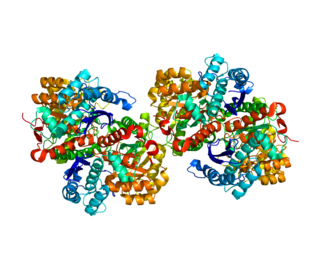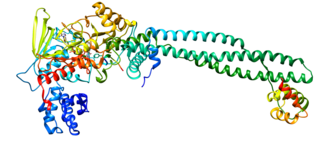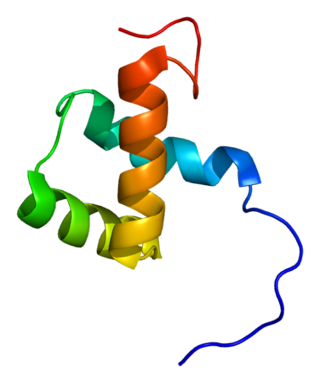Related Research Articles

T-box transcription factor T, also known as Brachyury protein, is encoded for in humans by the TBXT gene. Brachyury functions as a transcription factor within the T-box family of genes. Brachyury homologs have been found in all bilaterian animals that have been screened, as well as the freshwater cnidarian Hydra.

Protein inhibitor of activated STAT (PIAS), also known as E3 SUMO-protein ligase PIAS, is a protein that regulates transcription in mammals. PIAS proteins act as transcriptional co-regulators with at least 60 different proteins in order to either activate or repress transcription. The transcription factors STAT, NF-κB, p73, and p53 are among the many proteins that PIAS interacts with.

Signal transducer CD24 also known as cluster of differentiation 24 or heat stable antigen CD24 (HSA) is a protein that in humans is encoded by the CD24 gene. CD24 is a cell adhesion molecule.

Enolase 1 (ENO1), more commonly known as alpha-enolase, is a glycolytic enzyme expressed in most tissues, one of the isozymes of enolase. Each isoenzyme is a homodimer composed of 2 alpha, 2 gamma, or 2 beta subunits, and functions as a glycolytic enzyme. Alpha-enolase, in addition, functions as a structural lens protein (tau-crystallin) in the monomeric form. Alternative splicing of this gene results in a shorter isoform that has been shown to bind to the c-myc promoter and function as a tumor suppressor. Several pseudogenes have been identified, including one on the long arm of chromosome 1. Alpha-enolase has also been identified as an autoantigen in Hashimoto encephalopathy.

High-mobility group AT-hook 2, also known as HMGA2, is a protein that, in humans, is encoded by the HMGA2 gene.

B-cell lymphoma 3-encoded protein is a protein that in humans is encoded by the BCL3 gene.

Kruppel-like factor 4 is a member of the KLF family of zinc finger transcription factors, which belongs to the relatively large family of SP1-like transcription factors. KLF4 is involved in the regulation of proliferation, differentiation, apoptosis and somatic cell reprogramming. Evidence also suggests that KLF4 is a tumor suppressor in certain cancers, including colorectal cancer. It has three C2H2-zinc fingers at its carboxyl terminus that are closely related to another KLF, KLF2. It has two nuclear localization sequences that signals it to localize to the nucleus. In embryonic stem cells (ESCs), KLF4 has been demonstrated to be a good indicator of stem-like capacity. It is suggested that the same is true in mesenchymal stem cells (MSCs).

S100 calcium-binding protein A2 (S100A2) is a protein that in humans is encoded by the S100A2 gene and it is located on chromosome 1q21 with other S100 proteins.

Zinc finger protein SNAI1 is a protein that in humans is encoded by the SNAI1 gene. Snail is a family of transcription factors that promote the repression of the adhesion molecule E-cadherin to regulate epithelial to mesenchymal transition (EMT) during embryonic development.

Zinc finger E-box-binding homeobox 1 is a protein that in humans is encoded by the ZEB1 gene.

Sal-like protein 4(SALL4) is a transcription factor encoded by a member of the Spalt-like (SALL) gene family, SALL4. The SALL genes were identified based on their sequence homology to Spalt, which is a homeotic gene originally cloned in Drosophila melanogaster that is important for terminal trunk structure formation in embryogenesis and imaginal disc development in the larval stages. There are four human SALL proteins with structural homology and playing diverse roles in embryonic development, kidney function, and cancer. The SALL4 gene encodes at least three isoforms, termed A, B, and C, through alternative splicing, with the A and B forms being the most studied. SALL4 can alter gene expression changes through its interaction with many co-factors and epigenetic complexes. It is also known as a key embryonic stem cell (ESC) factor.

ID4 is a protein coding gene. In humans, it encodes for the protein known as DNA-binding protein inhibitor ID-4. This protein is known to be involved in the regulation of many cellular processes during both prenatal development and tumorigenesis. This is inclusive of embryonic cellular growth, senescence, cellular differentiation, apoptosis, and as an oncogene in angiogenesis.

Metastasis-associated protein MTA3 is a protein that in humans is encoded by the MTA3 gene. MTA3 protein localizes in the nucleus as well as in other cellular compartments MTA3 is a component of the nucleosome remodeling and deacetylate (NuRD) complex and participates in gene expression. The expression pattern of MTA3 is opposite to that of MTA1 and MTA2 during mammary gland tumorigenesis. However, MTA3 is also overexpressed in a variety of human cancers.

Lysosomal-associated transmembrane protein 4B is a protein that in humans is encoded by the LAPTM4B gene.

Eukaryotic translation initiation factor 5A-2 is a protein that in humans is encoded by the EIF5A2 gene.

ZNF703 is a gene which has been linked with the development of breast cancers. ZNF703 is contained within the NET/N1z family responsible for regulation of transcription essential for developmental growth especially in the hindbrain. Normal functions performed by ZNF703 include adhesion, movement and proliferation of cells. ZNF703 directly accumulates histone deacetylases at gene promoter regions but does not bind to functional DNA.

HOXA11-AS lncRNA is a long non-coding RNA from the antisense strand in the homeobox A. The HOX gene contains four clusters. The sense strand of the HOXA gene codes for proteins. Alternative names for HOXA11-AS lncRNA are: HOXA-AS5, HOXA11S, HOXA11-AS1, HOXA11AS, or NCRNA00076. This gene is 3,885 nucleotides long and resides at chromosome 7 (7p15.2) and is transcribed from an independent gene promoter. Being a lncRNA, it is longer than 200 nucleotides in length, in contrast to regular non-coding RNAs.

MIR22HG, also known as C17orf91, MGC14376, MIRN22, hsa-mir-22, and miR-22 is a human gene that encodes a noncoding RNA (ncRNA).This RNA molecule is not translated into a protein but nonetheless may have important functions.
The nuclear protein in testis gene encodes a 1,132-amino acid protein termed NUT that is expressed almost exclusively in the testes, ovaries, and ciliary ganglion. NUT protein facilitates the acetylation of chromatin by histone acetyltransferase EP300 in testicular spermatids. This acetylation is a form of chromatin remodeling which compacts spermatid chromatin, a critical step required for the normal conduct of spermatogenesis, i.e. the maturation of spermatids into sperm. Male mice that lacked the mouse Nutm1 gene using a gene knockout method had abnormally small testes, lacked sperm in their cauda epididymis, and were completely sterile. These findings indicate that Nutm1 gene is essential for the development of normal fertility in male mice and suggest that the NUTM1 gene may play a similar role in men.
References
- ↑ Maeda, Takahiro; Hobbs, Robin M.; Pandolfi, Pier Paolo (2005). "The Transcription Factor Pokemon: A New Key Player in Cancer Pathogenesis". Cancer Research. 65 (19): 8575–8578. doi: 10.1158/0008-5472.CAN-05-1055 . PMID 16204018.
- ↑ Guo, Changcheng; Xiong, Dabo; Yang, Bin; Zhang, Haiming; Gu, Wenyu; Liu, Min; Yao, Xudong; Zheng, Junhua; Peng, Bo (October 2017). "The expression and clinical significance of ZBTB7 in transitional cell carcinoma of the bladder". Oncology Letters. 14 (4): 4857–4862. doi:10.3892/ol.2017.6814. PMC 5649710 . PMID 29085492.
- ↑ Kukita, A; Kukita, T; Ouchida, M; Maeda, H; Yatsuki, H; Kohashi, O (15 September 1999). "Osteoclast-derived zinc finger (OCZF) protein with POZ domain, a possible transcriptional repressor, is involved in osteoclastogenesis". Blood. 94 (6): 1987–97. doi:10.1182/blood.V94.6.1987. PMID 10477728.
- ↑ "FBI1 (Human)".
- ↑ Komiya, Yuko; Akiyama, Hirotada; Sakumoto, Ryuji; Tashiro, Fumio (February 2014). "FBI1/Akirin2 promotes tumorigenicity and metastasis of Lewis lung carcinoma cells". Biochemical and Biophysical Research Communications. 444 (3): 382–386. doi:10.1016/j.bbrc.2014.01.064. PMID 24468084.
- ↑ Jiang, Yuyang (23 March 2012). "Zbtb7 suppresses the expression of CDK2 and E2F4 in liver cancer cells: Implications for the role of Zbtb7 in cell cycle regulation". Molecular Medicine Reports. 5 (6): 1475–80. doi: 10.3892/mmr.2012.846 . PMID 22447046.
- 1 2 3 4 5 "ZBTB7A - Zinc finger and BTB domain-containing protein 7A - Homo sapiens (Human) - ZBTB7A gene & protein". www.uniprot.org. Retrieved 2021-04-25.
- 1 2 3 4 5 6 7 8 Wang, Zexin; Zhao, Xilan; Wang, Wei; Liu, Yishu; Li, Yanyan; Gao, Junyong; Wang, Cancan; Zhou, Meiyu; Liu, Ruyan; Xu, Guofa; Zhou, Qi (2018-08-10). "ZBTB7 evokes 5-fluorouracil resistance in colorectal cancer through the NF‑κB signaling pathway". International Journal of Oncology. 53 (5): 2102–2110. doi: 10.3892/ijo.2018.4521 . ISSN 1019-6439. PMID 30106136.
- 1 2 3 Maeda, Takahiro; Hobbs, Robin M.; Merghoub, Taha; Guernah, Ilhem; Zelent, Arthur; Cordon-Cardo, Carlos; Teruya-Feldstein, Julie; Pandolfi, Pier Paolo (January 2005). "Role of the proto-oncogene Pokemon in cellular transformation and ARF repression". Nature. 433 (7023): 278–285. Bibcode:2005Natur.433..278M. doi:10.1038/nature03203. PMID 15662416. S2CID 4308742.
- 1 2 3 4 5 Qu, Hongyan; Qu, Danni; Chen, Fuhui; Zhang, Zhenyu; Liu, Baogang; Liu, Haifeng (June 2010). "ZBTB7 Overexpression Contributes to Malignancy in Breast Cancer". Cancer Investigation. 28 (6): 672–678. doi:10.3109/07357901003631007. ISSN 0735-7907. PMID 20394500. S2CID 26171423.
- 1 2 3 4 Guo, Changcheng; Xiong, Dabo; Yang, Bin; Zhang, Haiming; Gu, Wenyu; Liu, Min; Yao, Xudong; Zheng, Junhua; Peng, Bo (October 2017). "The expression and clinical significance of ZBTB7 in transitional cell carcinoma of the bladder". Oncology Letters. 14 (4): 4857–4862. doi:10.3892/ol.2017.6814. ISSN 1792-1074. PMC 5649710 . PMID 29085492.
- 1 2 3 4 5 Wang, Lihui; Li, Qi; Ye, Zhuo; Qiao, Baoping (2019-09-23). "ZBTB7/miR-137 Autoregulatory Circuit Promotes the Progression of Renal Carcinoma". Oncology Research. 27 (9): 1007–1014. doi:10.3727/096504018X15231148037228. ISSN 0965-0407. PMC 7848413 . PMID 29673422.
- ↑ Spelled like this in the original article; likely a misspelling of oncogenic
- ↑ Brendan Sinclair (2005-12-19). "Pokémon USA threatens to sue cancer researchers". GameSpot . Retrieved 2016-01-31.